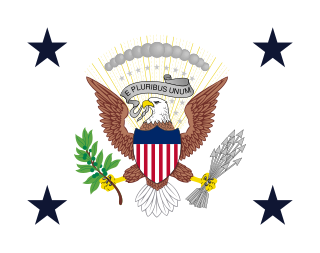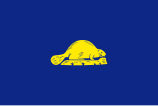
A flag is a piece of fabric with a distinctive design and colours. It is used as a symbol, a signalling device, or for decoration. The term flag is also used to refer to the graphic design employed, and flags have evolved into a general tool for rudimentary signalling and identification, especially in environments where communication is challenging. Many flags fall into groups of similar designs called flag families. The study of flags is known as "vexillology" from the Latin vexillum, meaning "flag" or "banner".

A national flag is a flag that represents and symbolizes a given nation. It is flown by the government of that nation, but can also be flown by its citizens. A national flag is typically designed with specific meanings for its colours and symbols, which may also be used separately from the flag as a symbol of the nation. The design of a national flag is sometimes altered after the occurrence of important historical events. The burning or destruction of a national flag is a greatly symbolic act.

The Great Seal is a national symbol of the United States. The phrase is used both for the impression device itself, which is kept by the United States secretary of state, and more generally for the impression it produces. The obverse of the Great Seal depicts the national coat of arms of the United States while the reverse features a truncated pyramid topped by an Eye of Providence. The year of the U.S. Declaration of Independence, 1776, is noted in Roman numerals at the base of the pyramid. The seal contains three Latin phrases: E Pluribus Unum, Annuit cœptis, and Novus ordo seclorum.

The flag of South Africa was designed in March 1994 and adopted on 27 April 1994, during South Africa's 1994 general election, to replace the previous flag used from 1928–1994.

The State Flag of the Union of Soviet Socialist Republics, or simply the Soviet flag, was a red banner with two communist symbols displayed in the canton: a gold hammer and sickle topped off by a red five-point star bordered in gold. The flag's design and symbolism are derived from several sources, but emerged during the Russian Revolution. It has also come to serve as the standard symbol representing communism as a whole, recognized as such in international circles, even after the dissolution of the Soviet Union in 1991.
Flag terminology is the nomenclature, or system of terms, used in vexillology, the study of flags, to describe precisely the parts, patterns, and other attributes of flags and their display.

The national flag of the Republic of Moldova is a vertical triband of blue, yellow, and red, charged with the coat of arms of Moldova on the centre bar. The reverse is mirrored. The flag ratio is 1:2. Until further provisions, the State Flag of Moldova is used as the national flag and ensign as well; that is, civil, state and war flag and ensign.

The flags of the U.S. states, territories, and the District of Columbia exhibit a variety of regional influences and local histories, as well as different styles and design principles. Modern U.S. state flags date from the turn of the 20th century, when states considered distinctive symbols for the 1893 World's Columbian Exposition in Chicago, Illinois. Most U.S. state flags were designed and adopted between 1893 and World War I.

The United States five-dollar bill ($5) is a denomination of United States currency. The current $5 bill features U.S. president Abraham Lincoln and the Great Seal of the United States on the front and the Lincoln Memorial on the back. All $5 bills issued today are Federal Reserve Notes. As of December 2018, the average life of a $5 bill in circulation is 4.7 years before it is replaced due to wear. Approximately 6% of all paper currency produced by the U.S. Treasury's Bureau of Engraving and Printing in 2009 were $5 bills.

The flag of Minnesota is the state flag of the U.S. state of Minnesota. Its design features a modified version of the seal of Minnesota emblazoned on a blue field. The flag's first version was adopted in 1893, in advance of the state's mounting an exhibition at the 1893 Chicago World's Fair. It was significantly revised in 1957 and received a minor update in 1983.

The current flag of South Dakota was adopted in 1992 to represent the U.S. state of South Dakota. It consists of a field of sky blue charged with a version of the state seal in the center, surrounded by gold triangles representing the sun's rays, surrounded in turn by inscriptions in gold sans-serif capitals of "south dakota" on top and "the mount rushmore state" on the bottom. The sun represents the common weather in South Dakota.

The flag of Washington consists of the state seal, displaying an image of its namesake George Washington, on a field of dark green with gold fringe being optional. It is the only U.S. state flag with a field of green as well as the only state flag with the image of an American president. The secretary of state regulates flag protocol related to the state flag, as well approving replica flags for commercial sale and other standards related to the flag.

The flag of West Virginia is the official flag of the U.S. State of West Virginia and was officially adopted by the West Virginia Legislature on March 7, 1929. The present flag consists of a pure white field bordered by a blue stripe with the coat of arms of West Virginia in the center, wreathed by Rhododendron maximum and topped by an unfurled red ribbon reading, "State of West Virginia." It is the only state flag to bear crossing rifles, meant to illustrate the importance of the state's fight for liberty during the Civil War as the southern unionist 35th state.

In military organizations, the practice of carrying colours, standards, flags, or guidons, both to act as a rallying point for troops and to mark the location of the commander, is thought to have originated in Ancient Egypt some 5,000 years ago. The Roman Empire also made battle standards reading SPQR a part of their vast armies. It was formalized in the armies of Europe in the High Middle Ages, with standards being emblazoned with the commander's coat of arms.

The following is a list of historical military colours, standards and guidons in different countries that do not exist today.

The Seal of the Commonwealth of Virginia is the official seal of the Commonwealth of Virginia, a U.S. state. The state flag of Virginia consists of the obverse of the seal against a blue background. A state flag was first adopted at the beginning of the American Civil War in April 1861, readopted in 1912, and standardized by the General Assembly in February 1950. The standing allegorical female figure of virtue is shown having vanquished tyranny, symbolized by a fallen king at her feet. She has an exposed breast in the manner of classical depictions of Amazons, making this the only state flag in the U.S. depicting a form of toplessness. The motto Sic semper tyrannis means "Thus always to tyrants." The flag may be decorated with a white fringe along the fly edge; this is usually done when the flag is displayed indoors.
The island nation of Malta has a variety of national flags and symbols, some current and some no longer in use.

The flag of the president of the United States consists of the presidential coat of arms on a dark blue background. While having the same design as the presidential seal since 1945, the flag has a separate history, and the designs on the flag and seal have at different times influenced each other. The flag is often displayed by the president in official photos, or flown next to the casket of a former president in official funeral processions, and flown on the president's motorcade. The flag is not flown at half-staff since there is always an incumbent president in office. The current flag is defined in Executive Order 10860:
The Color and Flag of the President of the United States shall consist of a dark blue rectangular background of sizes and proportions to conform to military and naval custom, on which shall appear the Coat of Arms of the President in proper colors. The proportions of the elements of the Coat of Arms shall be in direct relation to the hoist, and the fly shall vary according to the customs of the military and naval services.

The flag of the vice president of the United States consists of the U.S. vice presidential coat of arms on a white background, with four dark blue stars in the corners. A version of the flag is kept in the vice president's office, is sometimes displayed by the vice president in official photos, and is flown on the vice president's motorcade.






























